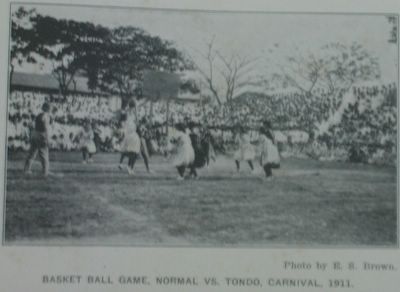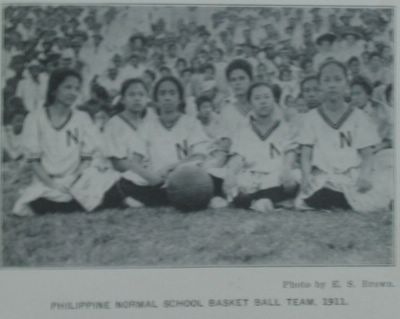God help me. Because I’m so dedicated to interactivity and serving my readers, I’m going to honor a request to write about the state of soccer in the Philippines during this World Cup season.
I’m sorry to say, however, that Soccer Nut’s request for “man-on-the-street” reporting on World Cup fever, or the lack thereof, will go unfulfilled. Futbol does come up relatively often in interviews with basketball people, though, so I’ll draw on their comments and some general observations to provide a glimpse of soccer’s draw in the Philippines.
As some readers may have guessed, World Cup fever is non-existent among most Filipinos. Hardly any games are played live on basic cable, which, when you consider the fact that we get badminton, table tennis, billiards, Indy car racing and a daily WNBA game, seems like a significant snub. Metro Manila has a large expatriate community and worldly elites who’ve traveled widely and studied at Western universities, and together they have made the World Cup scene quite lively at upper-crust lounges in Makati and Alabang. So, if you’re in the right place, you can catch a little Copa contagion, but usually those places look more like West Chelsea in New York than anywhere else in the Philippines.

|
If Manny isn't involved in the World Cup, then how can it be considered a major event? |
Surely, the World Cup organizers don’t fret over a scheduling conflict between the largest sporting event in the world and four boxing matches between Filipinos and Mexicans, but if they have any interest in the Philippine market, they should. The group stage and first two knockout rounds of the World Cup were overwhelmed by publicity leading up to Manny Pacquiao’s Sunday fight against Oscar Larios at the Araneta Coliseum, where Ali and Frazier fought the Thrilla in Manila in 1975.
No televised sporting event – not even basketball – captivates Filipinos like a Pac-Man fight. I stepped outside in between the second and third rounds Sunday to hear an eerie calm in my neighborhood. No tricycles buzzing people from point A to point B. No ya-yas ordering children around. No wandering vendors screaming “Tahoooooo!” Just silence until I started hearing cheers pop from all the open doors and windows in the neighborhood. The fight had resumed.
The fight itself pulled off the rare feat of being action-packed and boring at the same time. Manny pummeled Larios in nearly every round, but Oscar’s tough little tuckas kept plugging along in his Sisyphean way. It was more enthralling to watch Manny shatter his old record for most products endorsed in a two-hour time period, which seemed impossible after the endless parade of Pacquiao-themed commercials that aired during his January fight with Erik Morales. But Manny’s a warrior and you can never count him out. In between rounds Sunday, Manny peddled the X-Treme Magic Sing home videoke set, athletic socks, No Fear apparel, Ginebra San Miguel Gin, San Miguel Beer, McDonald’s fried chicken and Alaxan FR pain relievers. And those are merely the ads that come to mind first; I’m sure there were others. The clear winner is the videoke spot, which features Manny singing and dancing and showing off an impressive arsenal of awkward smiles. I’m praying they have this on YouTube. They don't. But here's McDonald's commercial starring the Pac-man.
I think the fight could have been more interesting if Manny’s sponsors required him to fight each round while using a different product. Sure, the sock and No Fear rounds would be uneventful, but we’d see what kind of man Manny really is in the rounds that require him to belt out OPM slow-jams like “Dahil Mahal Kita” (Because I Love You) while landing thunderous lefts to Larios’ jaw and the one where he throws back a few shots of Ginebra before dealing out an old-school ass-wooping.
The celebration in the streets afterward, the congratulations banners in the streets today were for Manny’s dominant performance. World Cup Fever was no match for Pac-Man Mania.
To some pundits, this is lamentable. I was quoted on the Philippine passion for basketball in a column in the South China Morning Post, which laments Filipinos lack of interest in soccer and its biggest event. I don’t agree with Alan Robles’ argument that Filipinos are “depriving themselves” by not following the world’s lead in adoring soccer or his implication that basketball is inferior to soccer because the former “has all the international reach of costumed wrestling.”

|
Now here's the perfect sport for this tropical nation. Smells like a delightful Cool Runnings sequel. |
Basketball and soccer are different sports. There’s no reason to anoint one as superior than the other and then force everyone to play and watch the winner. I also feel strongly that Filipinos – and anyone else, for that matter – are free to choose whatever sport pleases them best. Why should they favor soccer because it’s the most popular? Many Filipino pundits have claimed the nation should develop its soccer program at the expense of basketball because Filipinos are not tall enough to succeed at the highest level of international competition. But if world championships and Olympic medals are the goal, why not cultivate Filipino archers, curlers and rhythmic gymnasts? Find a sport no one else cares about, master it and watch the medals pour in. These writers are forgetting why people play sports – to enjoy themselves. You don’t need any other reason. If people in the Philippines like hoops the best, it’s their right to choose hoops.
I’m aware that one could argue that Filipinos’ didn’t choose to devote themselves to basketball, that it was implanted by American colonialism. But Americans tried a lot harder to force baseball on Filipinos, with poor results, so people here must have also found some innate joy in the game. Furthermore, once we start blaming current-day Filipino preferences solely on American influences, how far are we from denying the existence of free will and advancing a dated-behaviorist theory that the world is a giant Skinner box and people’s actions, attitudes and decisions are nothing but the results of positive and negative conditioning.

|
I'm sure this lucky son-of-a-gun thanks his European colonizers every day for bringing soccer to his land. |
And while we’re on the subject of colonial influences, I think Robles’ longing tone when he considers three “historical what-ifs” – chances for the Philippines to have been colonized by the British, Belgians and Germans – is a cute rhetorical maneuver but somewhat naïve. The United States’ colonial rule in the Philippines is nothing for Americans to be proud of. We beat Filipinos into submission and then ruled over the country with a sickeningly blithe air of paternalism, racism and missionary zeal. Still, it looks pretty damn enlightened compared to the way the Brits, Germans and Belgians raped Africa. I doubt Filipinos look at Africa – with AIDS ravaging parts of the continent; civil wars, lawlessness and warlordism that make the Philippine government’s conflicts with communists and Muslim separatists look like a Pre-K fight in the sandbox; and hunger and poverty just as bad as the Philippines – and say, “Those lucky bastards! They play soccer!”
Finally, I want to nit-pick Robles’ contention that importing American players is a sign of the decline in Philippine basketball. Imports have been a part of the game here since the 1970s, an era which is widely considered a golden age for Philippine basketball. Instead, it would be more accurate credit the PBA’s slide with the league’s openness to Filipino-American players, who, thanks to better coaching and competition in the States and the taller genes that often come with mixed blood, have crowded homegrown players out of the league and alienated some fans who want the national league to feature more born-and-bred Pinoys. There is no shortage of Filipino basketball players; Filipino-Americans are simply outcompeting many of them.
Robles is an accomplished, first-class columnist, but I disagree with his column. There is nothing wrong with Filipinos’ passion for basketball.



